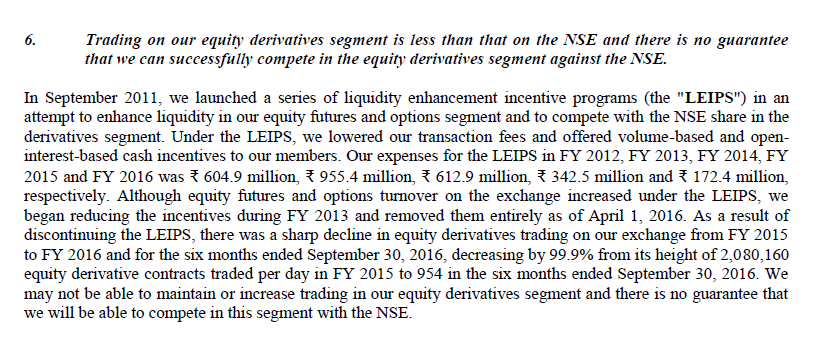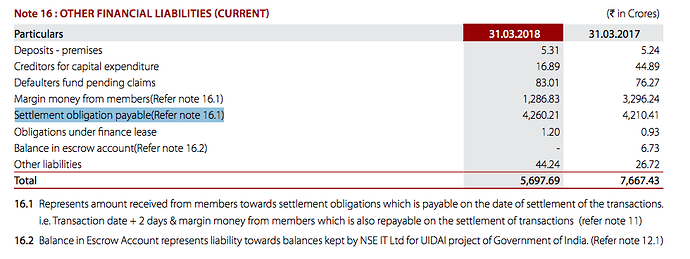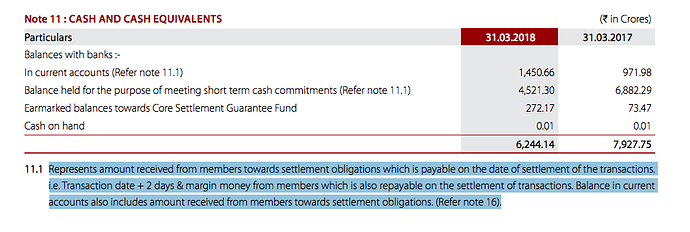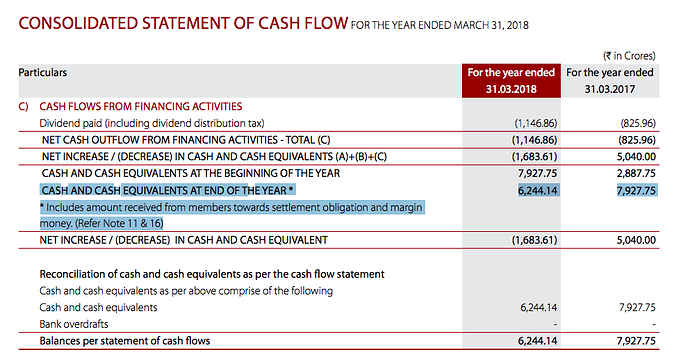BSE trying to cover the lost ground to NSE in Index Options by introducing weekly F&O contracts on Sensex 50 from Friday October 26.
This can be a game changer if BSE can gain volumes. (NSE is market leader in Nifty and Weekly Bank Nifty Options)
Appears that quite a few good initiatives are being taken
Hi All,
I recently started tracking about the company and as per my preliminary study it looks good to me … Just a doubt about its future growth although they are entering into the new segment like commodity , IEX but generating profit from them is quite far. They run on Discounted Model which is not very good model … BSE is all about a single man show ashish chauhan if he leaves the company in future will it impact BSE … I am looking BSE as a pure growth play … High Dividend yield is secondary for me … I request member if they can share there views inline with the above thought …
BSE has shown a poor 5% growth over last five years. Then, why do you consider this as pure growth play ?
Yeah Right but looking into the new foray they are entering
I also looked at it as a pure growth play and subscribed to the IPO. Turns out very few share the same sentiments.
Unless they show good growth, things will stay the same and we have to contend with good dividend.
SEBI not in favor of NSE MCX merger due to co-location controversy which can be good news for BSE
What is the source for this info?
I feel it would actually have been better for BSE considering that the market would then become purely duopolistic. Also, it would have made way for NSE to list earlier resulting in BSE getting a large cap name trading solely on its platform resulting in volume boost.
Source was business standard which is paid service hence did not post link. Agreed it could be either positive or negative news for bse.
I am trying to understand why OCF is negative / low for most years. Over 10 years, OCF is negative.
In Q1FY19 concall, management had provided below explanation for negative OCF.

My understanding is that STT is something that they are collecting from members and paying to the government. So there should not be any mismatch in cash flow due to this. All the settlements happen on T+2 basis so at max this amount of mismatch could be approx. 8-10 crores. (Mar 18 turnover -Rs.78,358 Cr. x 0.1% STT / 19 trading days x 2). This number cannot be 100 cr.
STT amount is infact providing float for few days in a month as members pay within 2 days and the payment is actually remitted to the government on monthly basis.
Am I missing something here?
Q2 Result are out…
Investor Presentation for Q2-Sept…
Do revenues include the STT collected? Because if they do, his point might be valid. Though it is not really relevant since BSE has been losing cash since a few years.
However, imo the real reason for negative operating cash flows is that BSE has mostly been giving out freebies or charging really low amounts for the services it offers in order to gain market share. In most of the past years the revenues from operations are lower than the expenses. The only reason it manages to survive are it’s huge cash reserves and the cash flows from its investing activities. The investment business funds the rest of its bleeding businesses. All of its new businesses are either free or charge lower amounts relative to NSE.
Excellent point of operating Cashflow of BSE being negative as per Screener Data. While the business model indicate that BSE should be free cashflow generating business, your post validly raised concern about why operating cahsflow being negative. Even I was surprised that I did not bother to check operating cashflow and just wen with assumption that stock exchage is free cashflow generating machine. So peronally was surprised when find that BSE has negative operating cashflow for most of years.
In order to understand cashflow better, I gone through itemwise operating cashflow from annual report over 5-6 years. I have combined heards in broad categories to my best understanding.
From my working, I realise two main factor contributing to volatile cash flow for BSE.
On first part, while for other manufacturing/service business, interest income is not operational cashflow and hence deducted from operational cashflow in accounting standard, same being applied to BSE. However, interest income on float is core business opeating income to BSE in my opinion and hence shall be consider as core operating revenue. I have added interest income in the operating cashflow in order to get true operating cashflow.
On working capital change, one more volaitlity is added due to Settlement obigation. Since BSE has now daily settlement, at the end of day, there is net amount to be paid to selling brocker versus buying brocker. While total purchase is equal to total sales and hence there should be no liability on BSE, ICCL being subsidiary honouring the settlement, the liability of account of settlement is appeaing in consolidated financial as Settlement obligation payable. There shall be matching assets on receivable amount from brocker. I am also not expert on account but that shall be case given every purchase on stock exchange shall corrosponding sale.
So in my understanding, one shall look at Operating cashflow before working capital change (at least in cosolidated account of BSE) and inclusive of Interest income which shall be true comparable to Free cashflow in my opinion.
I am enclosing my working in excel for everone reference. There may scope for error due to my limited understanding and would appreciate if other member highlight same.
Disclosure: BSE is among my Top 10 holding and my view may be biased due to my investment.
BSE cashflow calculation FY18.xlsx (12.8 KB)
Thanks for your reply.
As you rightly said, exchanges are cashflow generating business at operating level and hence my query was more on OCF being negative at standalone level.
I take your point on interest income but if you look at MCX’s OCF, they are positive even without considering investment income.
One explanation I could find for negative OCF was that they had spent around Rs.268.8 cr. on Liquidity Enhancement Incentive Programs (LEIPS) to boost derivatives business. This outflow did not yield any result and BSE could not fetch any market share from NSE.
Source: RHP Page 23.
Another exceptional item was Settlement Guarantee Fund (SGF). BSE had to transfer 25% of profits to SGF which resulted in Cash Outflow of Rs.72.2 Cr. for FY 2016 and Upto 29th Aug. 2016. (Source RHP Page 500, 501)
However, even after adjusting this Rs.269 Cr. + Rs.72 Cr., the OCF number is not impressive. I am not much aware about how stock exchanges account for settlement obligations. I will look into your calculations for WC changes and see if that can provide any reasonable explanation.
They now have LES (Liquidity Enhancement Scheme) for India INX where as per Q3FY18 concall they have spent around 12 Cr. for nine months. They expect this average to continue.
- This will impact consolidated CF.
- They clearly have market share advantage with India INX unlike derivatives business where inspite of spending such a huge sum, BSE was not able to take away any market share from NSE. However, we need to closely watch how competition decides to pump in money and how BSE responds to it.
On working capital change, one more volaitlity is added due to Settlement obigation. Since BSE has now daily settlement, at the end of day, there is net amount to be paid to selling brocker versus buying brocker.
Settlement Obligation Payable under OTHER FINANCIAL LIABILITIES represents amount received from members towards settlement obligation and margin money. This amount is included in CASH AND CASH EQUIVALENTS AND OTHER BANK BALANCES on the asset side.
From NSE’s AR:
NSE’s Operating Cash Flow summary for Standalone and Consolidated.
My moot point is why OCF over the years is minuscule on standalone basis for BSE.
Appreciate your working specially to get insight into NSE cashflow. So try to address the issue on two form:
First on Standalone: Since the Exchange does not take responsibility of Settlement (it is duty of Clearing Corporation promoted by exchange to guarantee settlement), there is no issue of Settlement obligation. However, there is regulatory liabilities (security transaction tax) and contribution to core guarantee funds. While not expert, but the exchanges are believe to contribute specific amount core guarantee funds. So the year in which STT fluctuation and Core guarantee settlement contribution are actually paid, we generally would get negative operating cashflow. However, that is assuming interest being non-operational. I still believe, like investment surplus is key to profitability of insurance business, one has to consider interest as core operating income for stock exchange. Even in NSE, in couple of years, when it contributed to core settlement funds, cashflow at standalone become negative.
Link for ICCL core guarantee fund contribution
http://www.icclindia.com/downloads/Contribution_to_Core_SGF.PDF
On second part when we consider consolidated financials. In that case, the clearing corporation (who is liable for settlement) is also included on consolidated working, we find liabilities (appearing in other current liabilities) are increased, but corresponding assets (i.e. cash received from members) are shown in Cash and bank balance. Since Cash and bank balance receipt on account of member settlement obligations are excluded, cashflow from operation are significantly affected from settlement obligation. Since it is contra entry (cash are lying in bank account), we shall exclude that specific item from calculation of operating cashflow and also add interest income to get true operating cashflow of Stock exchange. This is my understanding and it may be completely incorrect.
Discl: BSE is among my Top 10 holding and my view may be biased. Investors shall do their own due dilgence before making investment decision.







